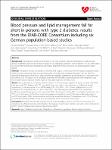Blood pressure and lipid management fall far short in persons with type 2 diabetes: results from the DIAB-CORE Consortium including six German population-based studies
Rückert, Ina-Maria
Schunk, Michaela
Holle, Rolf
Schipf, Sabine
Völzke, Henry
Kluttig, Alexander
Greiser, Karin-Halina
Berger, Klaus
Müller, Grit
Ellert, Ute
Neuhauser, Hannelore
Rathmann, Wolfgang
Tamayo, Teresa
Moebus, Susanne
Andrich, Silke
Meisinger, Christa
Background: Although most deaths among patients with type 2 diabetes (T2D) are attributable to cardiovascular disease, modifiable cardiovascular risk factors appear to be inadequately treated in medical practice. The aim of this study was to describe hypertension, dyslipidemia and medical treatment of these conditions in a large population-based sample. Methods: The present analysis was based on the DIAB-CORE project, in which data from five regional population-based studies and one nationwide German study were pooled. All studies were conducted between 1997 and 2006. We assessed the frequencies of risk factors and co-morbidities, especially hypertension and dyslipidemia, in participants with and without T2D. The odds of no or insufficient treatment and the odds of pharmacotherapy were computed using multivariable logistic regression models. Types of medication regimens were described. Results: The pooled data set comprised individual data of 15, 071 participants aged 45–74 years, including 1287 (8.5%) participants with T2D. Subjects with T2D were significantly more likely to have untreated or insufficiently treated hypertension, i.e. blood pressure of > = 140/90 mmHg (OR = 1.43, 95% CI 1.26-1.61) and dyslipidemia i.e. a total cholesterol/HDL-cholesterol ratio > = 5 (OR = 1.80, 95% CI 1.59-2.04) than participants without T2D. Untreated or insufficiently treated blood pressure was observed in 48.9% of participants without T2D and in 63.6% of participants with T2D. In this latter group, 28.0% did not receive anti-hypertensive medication and 72.0% were insufficiently treated. In non-T2D participants, 28.8% had untreated or insufficiently treated dyslipidemia. Of all participants with T2D 42.5% had currently elevated lipids, 80.3% of these were untreated and 19.7% were insufficiently treated. Conclusions: Blood pressure and lipid management fall short especially in persons with T2D across Germany. The importance of sufficient risk factor control besides blood glucose monitoring in diabetes care needs to be emphasized in order to prevent cardiovascular sequelae and premature death.
Dateien zu dieser Publikation
Keine Lizenzangabe

